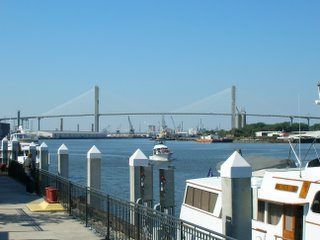According to the Atlanta Journal-Constitution, Georgia 400 will be widened from Holcomb Bridge Road (Exit 7 Southbound, Exits 7A-B Northbound) in Roswell to McFarland Road (Exit 12 Southbound, Exits 12A-B Northbound) in Forsyth County.
Please click here to read the article.
From the North Springs MARTA station (Exit 5C Southbound) to Windward Parkway (Exit 11), the shoulders were widened to accomodate buses, who are allowed to use them once traffic slows to 35 MPH or
less.
Currently, the Georgia DOT is in the process of replacing all the big green signs along Georgia 400.
A Brief History of Georgia 400The first phase of Georgia 400 was opened in 1968 from I-285 into North Fulton County.
Before 1979, it had been completed as far north as Georgia 306 (then-Exit 13, now Exit 17) in Forsyth County.
Originally, there were interstate aspirations for this highway that would have gone into North Carolina, possibly making it an Atlanta-to-Asheville interstate, but by 1979, the northern plans were "watered down" and Georgia 400 was extended north not as an interstate-standard highway, but instead as a 4-lane divided highway with at-grade intersections.
In 1979, the first phase was opened from Georgia 306 to Georgia 53 in Dawson County. (NOTE: The City ofAtlanta owns a lot of land in southern Dawson County near what is now the North Georgia Premium Outlet mall. That land was for a now-defunct proposed second Atlanta airport. If the airport were to have been built, then Georgia 400 would have been an interstate-standard highway at least as far as Georgia 53.)
It's final northward leg to Georgia 60 in Lumpkin County was completed in 1981. At that same time, US 19 was rerouted onto Georgia 400 from Roswell Road. From that point northward to Dahlonega, the original US 19 route became simply known as Georgia 9.
At the northern end of Georgia 400, US 19 joins Georgia 60, then it rejoins Georgia 9 just outside ofDahlonega at the Morrison Moore Intersection near North Georgia College (my alma mater). Originally, US 19 went into the Dahlonega town square. That stretch is now Business US 19/Business Georgia 60.
In August, 1993, the controversial southward extension from I-285 to I-85 was completed as a toll expressway.
Until the mid-1990's, mile markers ran continuously from I-85 (Mile 0) to Georgia 60 (Mile 52). The Georgia DOT changed them to start and end at each county line, just like non-interstate surface highways. That is why the exit numbers remain sequential.
Speaking of mile markers, there is a "Mile 24" marker at the new Exit 12B (McFarland Road West) in Forsyth County. Just before Exit 12A (McFarland Road East), there is a "Mile 1" marker. I guess somebody didn't "get the memo" on the mile marker change. :)
Original Georgia DOT plans had the southward extension proceed further south, parallelling US 23/Georgia 42 (Moreland Avenue), cutting through what is now the Carter Center at Freedom Parkway (originally proposed as the Stone Mountain Tollway/Georgia 410 and I-485), and ending at I-75. The part of Georgia 400 from I-285 in DeKalb County to I-75 at the Clayton/Henry County line eventually became I-675, which was completed in 1988.
My Upgrade Proposal (Forsyth and Dawson Counties)With the opening of the southern extension came a major growth spurt in Forsyth and Dawson Counties, said growth putting a major stress and strain on the infrastructures of that region... especially traffic.
Forsyth County alone has "exploded" since the 1990's, quickly transforming itself from a rural "all-white" area to a more diverse Atlanta suburb with an ever-increasing number of subdivisions and strip malls.
As of the 2000 Census, Dawson County was added to the Atlanta Metropolitan Statistical Area (MSA) due to its significant population growth... all because of Georgia 400.
The growth has not been kind to Georgia 400. In fact, the stretch north of Georgia 306 has become innundatedwith traffic lights and more and more strip malls, especially since the North Georgia Premium Outlet Mall was opened in the mid-1990s.
Given the growth and the increased traffic volume, I firmly believe that the Georgia DOT should look at upgrading Georgia 400 to interstate standards at least up to Georgia 53. To accomodate the businesses thathave since taken root, there could be a network of "frontage roads" built. Furthermore, there should be atleast 3 lanes on each side to accomodate traffic volumes. And another thing... this work should be done withno tolls such as those proposed for the Georgia 316 upgrades from Lawrenceville to Athens.
Those are my thoughts. What are yours regarding Georgia 400?
That's all for today. Thanks for visiting and please come again.
 Last weekend, my wife Mary and I went on a weekend getaway to Savannah to check out the sites.
Last weekend, my wife Mary and I went on a weekend getaway to Savannah to check out the sites.

